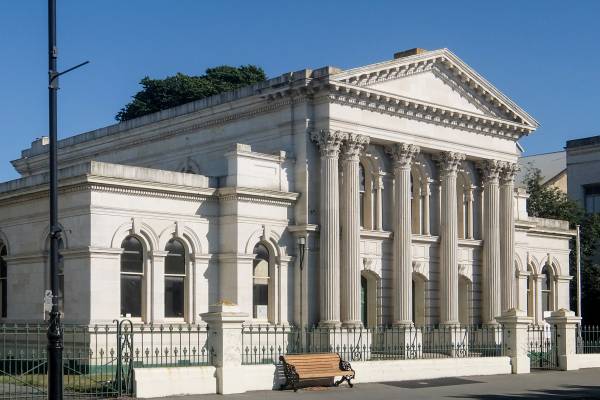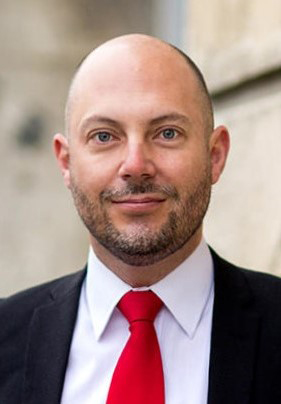In the mid-1800s, when Oamaru was the gateway to the Otago goldfields and bigger than Dunedin, more than 13% of the town’s population appeared in court.
The port town was called a drunken metropolis “full of inebriated sailors and prostitutes” and with the highest crime rates in Otago.
After the gold mining days Oamaru’s growth slowed and stagnated for several decades as development by-passed the coastal town.

This wasn’t helped in the mid-1980s, according to local lawyer Michael de Buyzer, by Rogernomics and retrenchment which saw a lot of departments of state leave town.
“There were challenges for many people in ensuring the district was adequately serviced by central government,” Michael says.
Today, Oamaru is proud of the good bits that grew from those turbulent times – mainly a fine collection of Victorian heritage buildings that arguably make the North Otago town New Zealand’s heritage centre.
But one of those fine buildings – the courthouse – was nearly lost.
“Port-a-court”
When earthquakes forced the closure of Oamaru’s grand Forrester and Lemon designed 135-year old courthouse in 2011 it looked as if justice would forever be meted out in a succession of temporary locations – including a “port-a-court” in a hotel carpark.

Until Bill Dean, one of Oamaru’s senior practitioners, a partner in Dean & Associates, and husband of National’s Waitaki MP Jacqui Dean, decided enough was enough.
Government engineers reckoned it would cost between $4 million and $6 million to make the courthouse fit for use – a figure Bill Dean and others regarded as insane.
He employed a civil engineer who costed the work at $350,000.
“I got resistance from Justice to even get the keys into the building,” Bill says. “Fortunately, I had Jacqui on my side and my good mate Chester Borrows was Courts Minister.”
Eventually, the local council stepped up in 2016, did a deal to acquire the land and building for a nominal amount, and spent $900,000 bringing the buildings up to the highest modern standard on the basis that the Ministry of Justice would rent it back as a hearing centre.
“It took several years for the paperwork to be accepted and remedial work to be completed. The courthouse needed to be saved for the community’s sake,” Bill says.
The modernised courthouse was opened late in 2018 and is back in business for court and other legal hearings, serviced from Timaru.
“You get embedded in Oamaru”
Having moved from the North Island for a couple of years’ experience, Bill is still there 35 years later – although he reckons he is in the process of retiring to go back to his former profession as a truck driver. “It’s an isolated job and I don’t have to worry about other people’s problems.”
“After a while you get embedded in Oamaru,” he says. “For a young couple maybe starting a family it’s one of the safest places in the country. The schools are fantastic. The place is humming. Tourism has gone through the roof with the preservation and use of old Victorian buildings.
“The Victorian quarter has filled up with commercial businesses, retail, cafes, a brewery. A whole lot of businesses sprang up on the back of the Victoria precinct.”
But like many small provincial towns it is not easy to attract lawyers to Oamaru.
It is easy to get a graduate who wants to get a couple of years’ experience before heading off to the bright lights or overseas, but attracting and retaining experienced practitioners is a different story.
“Those who stay, do so for a reason, usually family. We have had a fair share of graduates, in for a couple of years, then off, unless they become a parent – which we encourage.
“In my first two years in Oamaru I did six jury trials and won five of them, as well as urban and rural conveyancing, and commercial work. You become an able general practitioner.”
It’s where we live
Barrister sole Katherine Henry operates her part-time criminal practice from a two-acre block at Totara, south of Oamaru, where she helps her husband till the land to grow vegetables and create a self-sufficient food forest.

Katherine previously worked at Chapman Tripp in Wellington, and for Invercargill firms Southern Law, Hewat Galt Lawyers and Preston Russell Law – where she was a Crown prosecutor.
“We moved here in 2014 to live here and I practise here because we live here,” Katherine says. “It’s in the wider area where our extended families live.”
“For me it works well because I work from home part-time and as a barrister in the courts I probably wouldn’t be able to work part-time as I do if I was in a bigger centre.”
The Timaru District Court Judge Joanna Maze sits on Oamaru’s criminal list once a fortnight. There are no High Court sittings.
Katherine says smaller towns allow junior lawyers to have a broad range of practice areas and get involved in cases. “I worked for Chapman Tripp in Wellington doing civil litigation and was a small cog in a big machine. It was great but clients tended to be in-house lawyers or directors.
“When I moved to Invercargill I was dealing with a lot more mum and dad clients. I also worked for the Crown in Invercargill. In a smaller place I was working for smaller clients in smaller disputes which meant I could take a lead role.”
With three children, Katherine is a home educating parent, balancing home and work and says the family’s lifestyle is their relaxation. Katherine and husband Steven are building a straw bale house with heavy timber frames, which she says suits the environment.
“We are always planting trees and always outside with our children – and we go camping. My husband works on the land.
“For me as a sole practitioner not having a library is a challenge. I can’t afford to have everything and have a basic reference package. Sometimes I use the law library kiosks when I go to Timaru or Dunedin but it can be more of a challenge just finding time.
“Most of my work is legal aid so I have to be careful about what I subscribe to.”
Quirky call back home for local boy
A novel tongue-in-cheek advertisement placed by legal “character” Dick Crush attracted local-born Michael de Buyzer back to Oamaru from a Christchurch firm.

“My parents still lived here. I replied to Dick’s ad and got the job. I moved to see what it was like and 32 years later I’m still here,” says Michael.
Michael is a partner in Berry & Co, which also has offices in Queenstown and Invercargill. The firm has been a member of independent legal network NZ LAW Ltd for some time and was the first South Island firm to join. “It provides certain collegiality and idea sharing with lawyers in a myriad of different-sized firms.”
“This is a good, safe, friendly community with good schooling and opportunities to get into sporting and cultural clubs. Oamaru has been very kind to our family.
“Technical developments such as cell phone and electronic mail settlements at a distance tend to make life easier. There was a major challenge with the courthouse but that has been resolved.
“As lawyers we tend to get on well with one another. We respect each other and also stand up vigorously for our clients when required. But it never becomes acrimonious or personal.
“We get together from time to time socially and there is good collegiality between Oamaru and Timaru.”
Progressive attitude amid Victorian charm
Dean & Associates partner Ben Coleman says Oamaru – where 19 lawyers practise – is experiencing a resurgence of growth.
“Oamaru and the Waitaki economy is being revitalised. It is no longer a one trick pony supported by the primary industry sector.

“There is substantial growth and diversification into the services, tourism, retail, hospitality, manufacturing, commercial and property spaces. Some of New Zealand’s leading production companies who export all over the world base themselves here.”
Ben returned to New Zealand in 2002 after working for a major international law firm in London. After a year at the Bank of New Zealand in sales and compliance, a job came up in Oamaru.
“My mother has family in this area, so it was a natural choice and I have been with this firm ever since.
“I don’t think I would have foreseen staying when I first joined but it’s a fantastic town and the town and region have a strong growth up-curve and a good robust economy.”
Married with three children he says that increasingly, people, businesses and institutions in the region are becoming more industrious, ambitious and diligent.
“There is a progressive attitude whilst the charm and quirky niche of being a Victorian town with beautiful turn of the century architecture is retained. It’s exciting to be intrinsically involved in this growth by way of advising clients who are leading it.
“Some of my friends from Melbourne have visited and rate the historic precinct with its captivating and unique shops better than predictable high streets in cities.

“It’s a nice town to raise children in because it’s safe, the schools are good, people genuinely care and there are excellent facilities like the bike park. It’s not far away from the mountains or the beaches and we usually get to go home for lunch.
“There is definitely a real sense of community spirit and concern in Waitaki.
“The quality of the legal work is high and is expanding into a broader spectrum. Clients have high expectations and can be demanding; our office is very busy and I’m not usually home in the evenings until 7 or 8pm.
“There are plenty of opportunities for lawyers to make a positive impact in the community with volunteer work too – for example my partner Bill Dean’s involvement in rugby, mine as a director of the Highlanders and cricket and our associate Emma’s contribution to Waitaki Girls’ High School.”
Facts
- Of the Waitaki district’s population of 22,300, nearly 14,000 (63%) live in Oamaru. 91% of the population are European, compared with 74% for the whole of New Zealand.
- Every year more than 75,000 people visit Oamaru’s biggest tourist attraction – the little blue penguin colony.
- In 2014 Lonely Planet named Oamaru New Zealand’s coolest town, partly because of its historic Victorian precinct, Victorian Heritage Week, penguins and its Steampunk HQ.
- The many 19th century buildings constructed in distinctive “Oamaru stone” limestone means Oamaru’s Victorian precinct in the southern part of the town’s main commercial district ranks as one of New Zealand’s most impressive streetscapes.
- Oamaru made it into the Guinness Book of World Records in 2016 for the largest gathering of steampunks in the world – a term coined in the 1980s based on imagining inventions the Victorians might have created for the modern world and is something that has to be seen to be understood.
- Among famous folk born in or around Oamaru, or who stayed for a while, are writers Janet Frame, Owen Marshall, Greg McGee and Fiona Farrell Poole, broadcaster Jim Mora, former Australian Prime Minister Chris Watson, fellow politicians Arnold Nordmeyer and William Steward, and All Blacks Richie McCaw and Fred Allen.
- A strong community of living artists work in and around Oamaru and there are several dealer galleries in the historic quarter.
- The world first learned of the death of explorer Captain Robert Falcon Scott and members of his team on their return from the ill-fated expedition to the South Pole when Scott’s ship Terra Nova arrived in Oamaru on 10 February 1913, and the news spread worldwide.
- The median house value in Oamaru is just under $282,000.
Sources: Statistics New Zealand and Waitaki District Council
